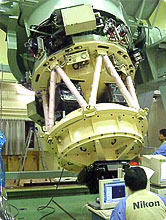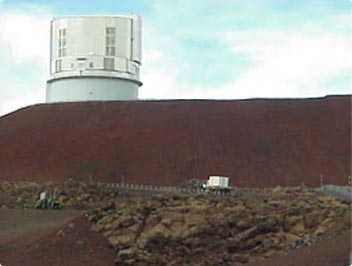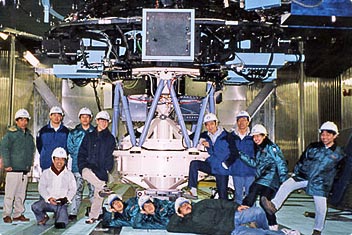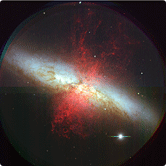
With an altitude of 4,200 meters, an atmospheric pressure of 0.6, and a temperature of 0oC, the summit of Mauna Kea, where the Subaru Telescope is located, might be described as an extremely harsh environment for moving precision optical equipment such as FOCAS. Nobunari Kashikawa, associate professor at the Subaru Telescope, the National Astronomical Observatory, who was in charge of the development of FOCAS, describes the difficulties encountered during development—from determining instrument specifications to carrying out on-site adjustment.
Wrestling with problems amid a lack of oxygen
What kind of operational testing did you carry out in the development of FOCAS?

Testing on the Cassegrain simulator at the National Astronomical Observatory in Mitaka.
During the development of FOCAS, the required components were constructed at the Astronomical Observatory's research center and at the Nikon factory. They were then integrated and mounted on the Cassegrain simulator set up at the National Astronomical Observatory in Mitaka. Together with the Nikon engineers, we then subjected them to repeated tests of all kinds. This process was completed in 1998. We then had to partially dismantle the instruments and transport them to Hawaii. Since this was the first time that we had ever sent observing instruments like FOCAS from Japan overseas, it took longer to get them through customs than we had imagined. I waited a month in Hawaii for them to arrive (laughs).
We then mounted the instrument on the Cassegrain simulator installed at the Hilo base camp facility*1 and repeated the same tests that we had carried out at Mitaka once again. The Cassegrain simulator consists of a platform section that emulates the movement of the Subaru Telescope's Cassegrain focus, whose inclination changes in accordance with the orientation of the telescope. It also offers power supply and network connectivity.
The reason for this was that once the equipment was on the summit of Mauna Kea, it would be extremely difficult to repair anything, should there be a problem. In addition, once the instrument was mounted on the Subaru, it would occupy the Cassegrain focus, making it impossible to conduct tests on other observing instruments. Our overall policy in the development of the Subaru Telescope was to try and minimize the amount of work that would be performed at the summit.
We again encased the instrument in special air-tight packing designed to reduce vibration, and gingerly carried them to the summit—taking an entire day to traverse a route that normally requires only two hours. This was because the atmospheric pressure differs between the lowlands and the summit, causing the humidity to change significantly as you pass through the clouds on the way up. On this occasion we were also accompanied by Nikon engineers, who provided us with advice on various issues.
- *1 The National Astronomical Observatory's Hilo base camp facility on the island of Hawaii.
Please tell us about the trials and tribulations that you experienced before FOCAS became operational.

FOCAS headed for the Subaru Telescope after the completion of testing at the Hilo base camp facility.
For this reason, we would make a record of our difficulties and the conditions at the summit, and go back down to the Astronomers' Mid-Level Facility*2 at Hale Pohaku, which is at an altitude of 2,800 meters. Here, we would discuss matters with everyone, look for ways to solve the problems, and try them out the following day in a continuous process that lasted for approximately two weeks. It was also extremely difficult for us to establish the necessary observation parameters that would enable the use of FOCAS by ordinary researchers who knew nothing about it. During the first stage—known as Engineering First Light—we repeatedly conducted ordinary observations, and developed the observation process, while writing the manual and evaluating the capabilities of FOCAS at the same time.
Afterwards, the developers were awarded “guaranteed time,” in which they could use FOCAS freely as a form of compensation for their efforts; however, this time too was devoted to performing adjustments. From 1999 to 2000, we were conducting operational testing of FOCAS round the clock—including Christmas and New Year (laughs). We finally made it to Scientific First Light—the acquisition of observational data—and we were elated when we finally obtained such a beautifully clear image of M82. This made us want to get the adjustments out of the way as soon as possible and conduct our own observations.
- *2 The Astronomers' Mid-Level Facility at Hale Pohaku, which is jointly managed by 11 nations, including Japan and the United States, to provide astronomers engaged in observation at the summit a place to eat and sleep. (Altitude: 2,800 m, atmospheric pressure: 0.8)

After completion of installation at the Cassegrain focus and adjustment. Commemorative picture featuring all members of staff (February 6, 2002).

FOCAS First Light image (observation date: February 2, 2000). A distinct image showing red light, Hα radiation, given off by ionized hydrogen gas spreading out from the central portion of M82 (NGC3034).
With the development of the Subaru Telescope, there was a first time for everything and when a problem occurred you could never predict what the cause might be. All you could do was to investigate patiently and thoroughly, and solve the problem. Right now, I only go to Hawaii for my own observation time—four or five times a year, with a stay of about a week each time. However, when we were starting up, I was probably trekking back and forth to the summit for about four months straight.
FOCAS is now running in an extremely stable fashion. This is probably because, in the first place Nikon's basic optical design is sound, and because Nikon considered the issue of flexion in the main body in advance. I think that this is probably also why the Multi-Object-Slit mechanism (MOS) and CCD cameras that we built are working. When data that has been obtained from a target celestial object as anticipated appears on the monitors in the observation room inside the Subaru Telescope, I feel an enormous sense of elation.
- The images used in this article were provided by the National Astronomical Observatory of Japan.
Posted January 2008

